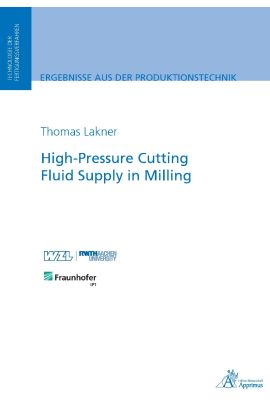The scientific goal of this work was to investigate the fundamental mechanisms involved in the high-pressure supply of cutting fluids during milling. These results shall enable a knowledge-based cutting fluid supply. The economical target was set to markedly increase the efficiency, the tool life and the productivity of milling processes.
The engagement conditions in milling differ substantially from those in turning due to the interrupted nature of the cutting process and the discontinuous undeformed chip thicknesses. Therefore, a novel analogous test bench was developed that allows to quantify the alternating thermo-mechanical tool loads in milling. Furthermore, the fundamental correlation between the cutting fluid supply parameters and the chip form was elaborated. Based on these results, the cooling efficiency of the cutting fluid was quantified and the influence of the coolant nozzle orientation on the chip form and the tool wear was determined. The core finding of these investigations was that the coolant nozzle orientation has to be designed specifically for the machined workpiece material. The material specific cutting fluid supply can increase tool life by more than 50 %. The potential of adjusted coolant nozzle geometries to reduce tool wear was also verified with additively manufactured milling cutters.
The tribological process parameters during the interrupted contact with a high-pressure cutting fluid supply were investigated using a novel test bench. The supply pressure and the volumetric flow rate had a distinct influence on the friction coefficient for TiAl6V4, while they were negligible for 42CrMo4+QT. Fluid-mechanical analyses of the cutting fluid supply system revealed that pressure losses of more than 70 % can occur in state-of-the-art machine tools. In addition, the influence of the tool rotation on the cutting fluid free jet was analyzed on another test bench.
The findings from this work were incorporated in a design model through the Network Thinking method according to GOMEZ and PROBST. A demonstrator tool was designed using the model and compared to a state-of-the-art tool to validate the design model. In this context, a 50 % increase in productivity was achieved. Economically, this corresponds to cost savings of up to 29 %. From an ecological perspective, the energy consumption decreased, because the higher nominal power consumption of the high-pressure cutting fluid supply was compensated by a reduction in processing time.
| Autor | Lakner, Thomas |
|---|---|
| Gewicht | 0.299 kg |
| Erscheinungsdatum | 05.08.2021 |
Eigene Bewertung schreiben
Technologie der Fertigungsverfahren
High-Pressure Cutting Fluid Supply in Milling
ISBN: 978-3-86359-977-5
Lieferzeit: 2-3 Tage
39,00 €
inkl. 7% MwSt.
Kurzbeschreibung
Die fundamentalen Wirkmechanismen der Hochdruck-Kühlschmierstoffzufuhr bei der Fräsbearbeitung wurden mittels zerspantechnologischer, tribologischer und fluiddy-namischer Untersuchungen in dieser Arbeit erforscht. Das erarbeitete Wissen wurde in ein Gestaltungsmodell überführt, um die Erkenntnisse dem Endanwender nutzbar zu machen. Durch den Einsatz der erforschten Technologie konnten Produktivitäts-steigerungen von maximal 50 % und Kostenersparnisse von bis zu 29 % erreicht werden.
Auf Lager

